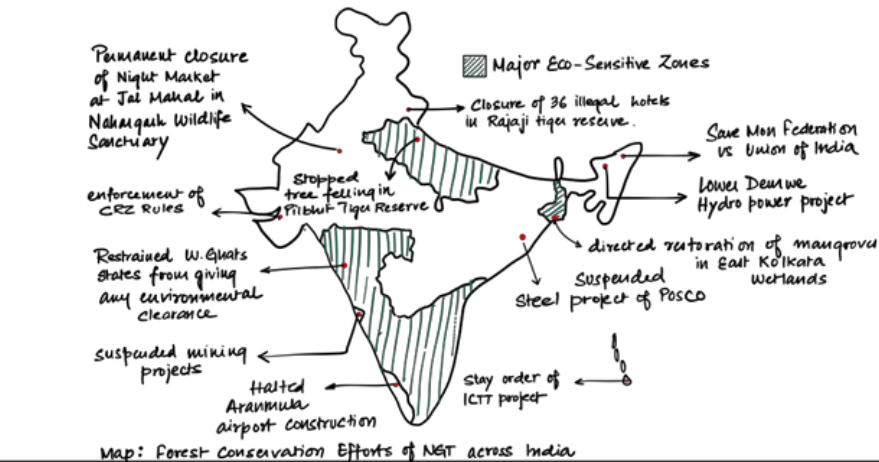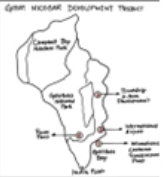
The National Green Tribunal Act, of 2010 has emerged as a pivotal legal framework in India, significantly influencing the landscape of environmental conservation, particularly in the realm of forest protection. Enacted to expeditiously resolve environmental disputes and promote sustainable development, the National Green Tribunal (NGT) has played a crucial role in shaping policies and decisions related to forest conservation in the country. Since its inception, the NGT has become a key institution for adjudicating matters concerning the environment, including deforestation, illegal logging, and habitat degradation. This essay will delve into the profound impact of the National Green Tribunal Act, of 2010 on forest conservation in India, analyzing its role in shaping policies, enhancing accountability, and fostering a more sustainable approach toward the preservation of the nation’s vital ecosystems.
Contents
Answer
Over the years NGT has emerged as a critical player in environmental regulation, passing strict orders on issues ranging from deforestation, pollution, waste management, and other environmental issues.

How effective has it been?
Effectiveness in Mangrove conservation:

- Enforcement of Mangrove Protection Laws: Eg- In 2018, NGT ordered Gujarat to enforce CRZ rules for coastal mangrove protection.
- Has taken legal action against violators: Eg- In 2022, NGT directed the demolition of unauthorized structures near mangroves in the Thane and Vasai-Virar areas.
- Has played an active role in monitoring the conditions of mangroves. Eg- In 2020, it directed the restoration of damaged mangroves in the East Kolkata Wetlands.
- Has involved local communities in mangrove conservation. Eg- NGT emphasized community
engagement and sustainable management in the preservation of the Bhitarkanika mangroves.
Effectiveness in forest conservation of Hill areas:
- Has stopped construction activities in environmentally sensitive hill areas. Eg- Halt in construction activities by NGT in the eco-sensitive zone of Rohtang Pass in 2015
- Has regulated mining activities. Eg- Ban on all mining activities in Aravali hills of Haryana and Rajasthan
- Restoration of Ecologically Sensitive Zones: In 2020, NGT directed the states of Maharashtra and Goa to take measures to restore and protect the ecologically sensitive zones in the Western Ghats.
- Has promoted Afforestation initiatives. Eg- NGT directed the state government to undertake largescale afforestation after Uttarakhand land subsidence
Effectiveness in forest conservation of National Parks:
- Has imposed restrictions on commercial activities within national parks and wildlife sanctuaries.
Eg-
● Permanent closure of Night Market at Jal mahal in Nahargarh Wildlife Sanctuary
● Closure of 36 illegal hotels in Rajaji Tiger Reserve - Issued directives to prevent damage to forests within protected areas. For ex- Stopping tree felling by UP government in Pilibhit Tiger in 2019
- Monitored the ecological impact of developmental activities near national parks. For exmonitoring of ecological restoration efforts in the vicinity of the Mahendragiri Wildlife Sanctuary in Odisha.
Effectiveness in Ensuring Environmental Accountability:
It has protected the rights of tribal communities and ensured the enforcement of the “polluter pays” principle in letter and spirit.
For example-
- In 2012, suspended an order of POSCO Steel Company to set up a steel project in Odisha, thus favoring the local communities and forests.

- In the Save Mon Federation Vs Union of India case (2013), the NGT suspended a
₹6,400-crore hydro project in Nyamjang Chhu River in Arunachal Pradesh, to save a forest that was the habitat of the Monpa indigenous community.
Case Study: Stay Order on ICTT project in Great Nicobar Island
The National Green Tribunal has ordered a stay on the ICTT and formed a committee to re-examine the environmental clearance granted.
Effectiveness as a vigilant in Forest Conservation
December 2016 amendment to EIA 2006 notification — the amendments basically sought to give local authorities’ powers to grant environmental clearance to builders — was nullified by the NGT, terming it as a “ploy” (by the government) to circumvent the 2006 rules.
Many Projects which were approved in violation of the law such as:
- Aranmula Airport, Kerala;
- Lower Demwe Hydro Power Project
- Nyamjang in Arunachal Pradesh; mining projects in in Goa;
- coal mining projects in Chhattisgarh were either canceled or fresh assessments were directed
Where it has failed?
- Conservation of Himalayan Hotspot in the North-East. Eg- Despite NGT’s intervention, illegal logging activities continue in Arunachal Pradesh, which is destroying the habitat of the rare Hornbill.
- Stopping deforestation of Aravalis as a whole.
- Despite the Gadgil Committee and Kasturirangan Committee recommendations, it has not been as effective in the Western Ghats.
- NGT has permitted the government to widen the roads of the Chardham Project despite potentially hazardous impact on the Himalayan ecology.
- It has not been successful in stopping EIA projects.
- It did not take action when the Forest Conservation Act was amended in 2023 which eased the clearance process for development projects in forested areas and reduced regulatory oversight.
Case study: Ken-Betwa River Linking Project- The Ken-Betwa River Linking Project in Madhya Pradesh has faced concerns over its environmental impact, including the submergence of forests and wildlife habitats. Despite opposition and environmental concerns, the project has been approved and continues to progress, raising questions about the ability of the NGT to influence or halt large-scale, nationally significant projects.
In recent times, the importance of NGT has increased. However, its effectiveness is being compromised.
- Two important acts – Wildlife (Protection) Act, 1972 and Two and Other Traditional Forest Dwellers (Recognition of Forest Rights) Act, 2006 have been kept out of NGT’s jurisdiction.
- NGT decisions were challenged in High Courts under Article 226, claiming that NGT is a Statutory body whereas HC is a constitutional body
- The lack of human and financial resources has led to a high pendency of cases – which undermines NGT’s very objective of disposal of appeals within 6 months.
- The absence of a formula-based mechanism in determining the compensation has also brought criticism to the tribunal.
- The justice delivery mechanism is also hindered by a limited number of regional benches.
Conclusion
While NGT remains a “proactive inconvenience” to all those who take actions that make economic growth ecologically unsustainable, there is a need for more autonomy to widen NGT’s scope for effective protection of the environment in balance with human developmental activities.
In case you still have your doubts, contact us on 9811333901.
For UPSC Prelims Resources, Click here
For Daily Updates and Study Material:
Join our Telegram Channel – Edukemy for IAS
- 1. Learn through Videos – here
- 2. Be Exam Ready by Practicing Daily MCQs – here
- 3. Daily Newsletter – Get all your Current Affairs Covered – here
- 4. Mains Answer Writing Practice – here

